Related Topics
Colonial Philadelphia (Pre- 1776)
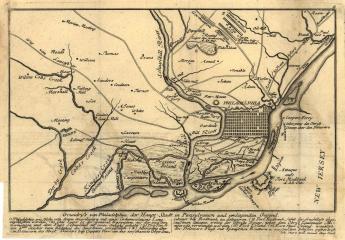 It's surprising to most Americans to learn the American Revolution was not the beginning, but almost half-way through the European settlement. And before the Revolution, there were thousands of years of settlement by non-European tribes. We know more about non-European settlers than we did fifty years ago, but records are still very poor or non-existent, and not likely to catch up very rapidly. History will begin in 1492 for a very long time. Long before that, it isn't history, it's anthropology.
It's surprising to most Americans to learn the American Revolution was not the beginning, but almost half-way through the European settlement. And before the Revolution, there were thousands of years of settlement by non-European tribes. We know more about non-European settlers than we did fifty years ago, but records are still very poor or non-existent, and not likely to catch up very rapidly. History will begin in 1492 for a very long time. Long before that, it isn't history, it's anthropology.
Particular Sights to See:Center City
Taxi drivers tell tourists that Center City is a "shining city on a hill". During the Industrial Era, the city almost urbanized out to the county line, and then retreated. Right now, the urban center is surrounded by a semi-deserted ring of former factories.
Conventions and Convention Centers
When you have a big convention center, some circus is always coming to town. Philadelphia has always been a convention town, has had and still has lots of convention sites, and hopes to have more of the kind of famous convention we have had in the past.
Revolutionary Philadelphia's Patriots
All kinds of people were patriots in 1776, and many of them were all mixed up about what was going on and how they stood. Hotheads in the London Coffee House stirred up about an inoffensive Tea Act, Scotch-Irish come here to escape the British Crown, the local artisan class and the local smuggler class, unexpectedly prospering under non-importation, and the local gentry -- offended to be denied seats in Parliament like other Englishmen. Pennsylvania wavered until Ben Franklin stepped forward with a plan.
Tourist Walk in Olde Philadelphia
Colonial Philadelphia can be seen in a hard day's walk, if you stick to the center of town.
Up Market Street to Sixth and Walnut
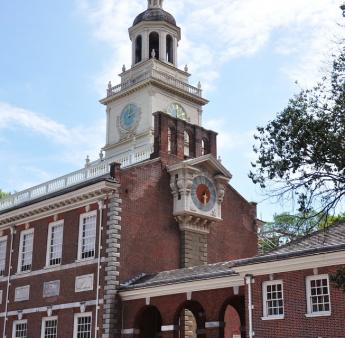 Millions of eye patients have been asked to read the passage from Franklin's autobiography, "I walked up Market Street, etc." which is commonly printed on eye-test cards. Here's your chance to do it.
Millions of eye patients have been asked to read the passage from Franklin's autobiography, "I walked up Market Street, etc." which is commonly printed on eye-test cards. Here's your chance to do it.
Carpenters Hall
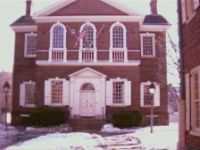
|
| Carpenters Hall |
The birthplace of our nation is both smaller than you would expect and larger. The fire marshall now says no more than 83 people may rent it for a sit-down affair, or 103 for a stand-up gathering. However, the internal partitions have been removed from what was once a center-hall building with a meeting room on either side; it now is a large open room in the form of a Greek cross. At the time of the revolution, Benjamin Franklin's Library Company occupied the second floor, so the First Continental Congress had to find a way to do its work in the side rooms of the first floor, to the side of the center hall. There were 53 delegates, and presumably some staff and visitors.
That sounds rather crowded, but it was nevertheless the largest rentable public space in the city. John Adams arrived early for the convention, conniving with several other early arrivals at the City Tavern. Adams made the following notation in his diary: Monday. At ten the delegates all met at the City Tavern and walked to the Carpenters' Hall, where they took a view of the room, and of the chamber where is an excellent library; there is also a long entry where gentlemen may walk, and a convenient chamber opposite to the library. The general cry was, that this was a good room, and the question was put, whether we were satisfied with this room? and it passed in the affirmative." Alternative places to meet would have been in churches, which presented awkwardness, or in the State House (Independence Hall) which was then under the control of Tories.
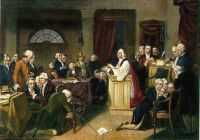
|
| Continental Congress |
France and the rebellious colonies was a complicated one, with intrigue and mistrust at every turn. One interesting episode had to do with Franklin's library on the second floor. The French ministry had sent over a spy, to size up the colonists before the French risked too much on them. So, the spy was led up to the library and allowed to overhear some bellicose conversations going on downstairs -- thoroughly stage-managed for the benefit of the "hidden" French visitor.
The Carpenters Company was a guild of what we would now call builders and architects, and architects continue to use it. The first floor usually displays a few Windsor chairs dating to the Continental Congress, covered with a rich black patina that really lets you know what a patina was. Upstairs, the staff quarters are now, well, a little on the elegant side so you can't visit. The guild was formed in 1724, and fifty years later had just completed its building, in time for its historic role in 1774.
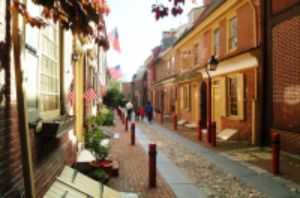
|
| Elfreth's Alley |
With the whole continent available for building, it is still not entirely clear why Colonial Philadelphia crowded itself into half a square mile, with crowded little row houses on crowded little alleys. But that's the way it was, now visible in the location of Carpenters' Hall down a little cobbled alley, in the center of a block. Elfreth's Alley gives you the same feeling, and perhaps Camac, Mole, and Latimer Streets. Carpenters' is a lovely little place, with lots of interesting features, but the main interest lies in what took place there. For that, you have to read a few books.
Originally published: Wednesday, June 21, 2006; most-recently modified: Monday, May 20, 2019
| Posted by: Jodie | Jan 3, 2012 9:48 AM |
| Posted by: Anonymous | Mar 17, 2009 12:51 AM |